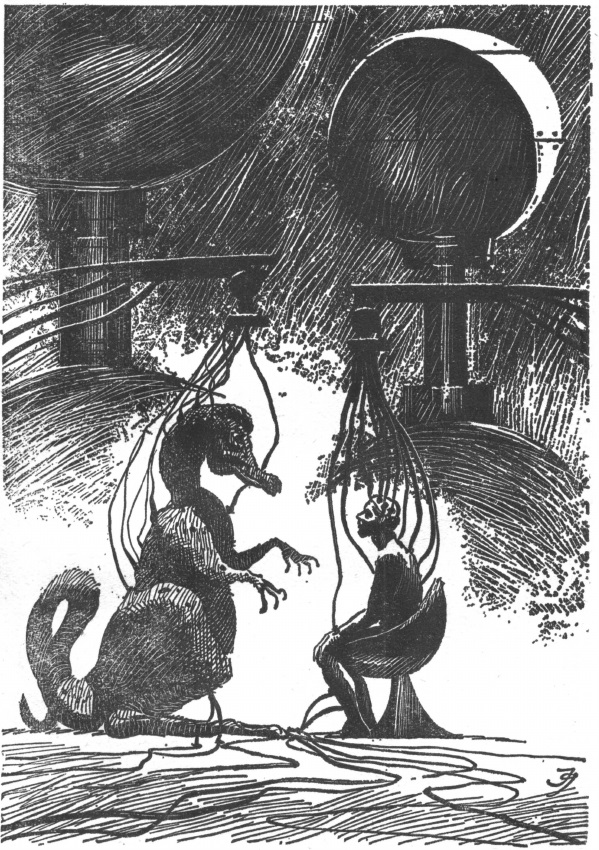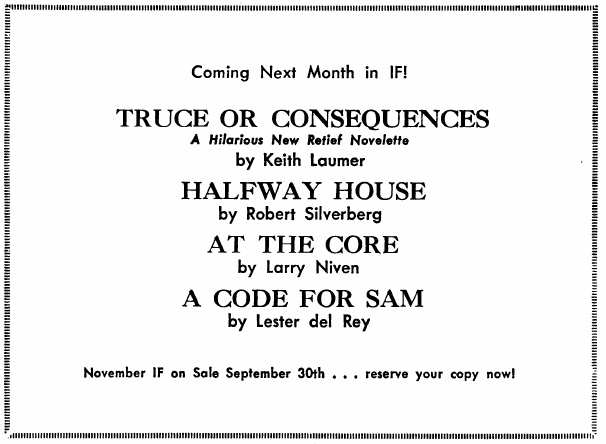
by David Levinson
Big Trouble in China
Back in May, I wrote about the political maneuvering going on in China, and I predicted purges would follow. Rarely have I been so sorry to be right. On August 13th, Mao Tse-tung announced a purge of Party officials as part of the Cutural Revolution. And he has a frightening new tool to carry out his will.
At the end of May, a group of high school and university students calling themselves Red Guards embraced the principles of the Cultural Revolution and hung up posters criticizing university administrators. Originally condemned as counterrevolutionaries and radicals, they were officially endorsed by Mao early in August. On the 18th, a mass rally was held in T’ien-an-min Square in Peking. A reported one million students listened to speeches by various Party officials. Mao appeared in military fatigues for the first time in years, a look favored by the Red Guards.

On the 22nd, they began putting up posters “advising” people to abandon bourgeois habits such as Western clothing and warned shopkeepers against selling foreign goods. They gave people a week before they would “take action”. Since then, the Red Guards have run amok. On the 26th, they gave foreigners and bourgeois Chinese to the end of the day to leave Peking. They poured into the Tibetan capital Lhasa, destroying ancient relics, vandalizing shrines and abusing monks. Now, word has come out that they are beating and killing people in the Ta-hsing and Ch’ang-p’ing districts of Peking, and the police have been ordered to look the other way. This is likely to get worse before it gets better, and however it ends won’t be pretty.

Soong P’in-p’in, a Red Guard leader, pins an armband on Mao Tse-tung.
Life on the edge
This month’s IF features not one, but two stories set on the edge of the galaxy, and just about everyone else is on the edge in some way or another.

Amazingly well done for Dan Adkins. Art by Adkins
TV by the Numbers, by Fred Pohl
We rarely mention editorials, but this one’s interesting. A recent discussion with Murray Leinster about one of his patents that lets TV studios use a photograph of a set backdrop in place of the physical thing got Fred to thinking. A single line on a black-and-white TV screen consists of around 420 phosphor dots that are either on or off. With 525 lines to a frame, it would take a string of 220,000 ones and zeros to describe one frame. A 25 billion digit number would be enough for a one hour show; 600 billion for 24 hours. But you probably need a lot less. In the thirtieth of a second between frames, most of those dots don’t change, so it should be possible to find a way to tell the TV to only change certain spots from the last frame. Could there come a day when not only the stage sets, but even the actors aren’t real?
Neutron Star, by Larry Niven
Out-of-work space pilot Beowulf Shaeffer is facing debtor’s prison when an alien blackmails him into taking on a suicide mission. The puppeteers (something like a headless, three-legged centaur with Cecil the Seasick Sea Serpent puppets for arms) have a near-monopoly on spaceship hulls, which are supposed to be impervious to everything except visible light. But something reached through one of their hulls and reduced two scientists studying a neutron star to bloody smears. Now Shaeffer finds himself following the exact same course, and he has to figure things out before he meets the same end.

Beowulf Shaeffer aboard his invisible starship. Art by Adkins
A nice little problem story. While the answer may seem obvious to the reader, that answer is incomplete. There’s a subtle bit more to it that the puppeteers can’t see, and the reason they can’t see it means a sizeable bonus for Shaeffer. Another detail has Shaeffer recording everything happening, so there is some record if he’s killed. In an interesting coincidence, a voice recording is being analyzed for the first time in the investigation of a plane crash in Nebraska last month.
Three stars.
Your Soldier Unto Death, by Michael Walker
The centuries-long war with the Kreekal has ground to an end. With their hive-like society, the alien soldiers were specially bred to fight. Ultimately, humanity began raising soldiers from birth to do two things: to hate Kreekan soldiers and to be good at killing them. Now that the war is over, what do you do with 5 billion soldiers who are barely human?
While there’s some apparent skill in the writing, Walker is this month’s new writer — and you can tell. The pieces don’t quite fit together, and most of the story consists of people sitting around talking about things. The germ of a good story is here, but the author just isn’t up to it.
A high two stars.
Snow White and the Giants (Part 1 of 4), by J. T. McIntosh
In the quite English country town of Shuteley, sweltering under the hottest summer on record, Val Mathers wishes something would happen. His marriage to Sheila is in a rough situation, partly because of a difference over whether to have children, partly because of his mentally handicapped sister Dina, who lives with them, and partly because his old school friend Jota seems to have tried to force himself on Sheila three years earlier. Now Jota is on his way back from his job in Cologne, Dina is worried about the fairies in the garden, and a strange group of young tourists has appeared in town.
With one exception, these tourists are all very tall and very fit. The women wear dresses that seem to disappear occasionally, causing a commotion. The exception, whom Val dubs Snow White for her fair skin and dark hair, differs from the others only in her size. They all behave a bit oddly and when asked where they’re from, they reply “Here.” Even stranger, they all seem to know Val and are expecting Jota. After Jota arrives in town, he and Val decide to investigate where the strangers are camping. To be continued.

Val and Sheila investigate strange lights at the bottom of the garden. Art by Gaughan
It’s difficult to judge where this is going, since this installment is almost all McIntosh setting the scene. None of the characters are terribly appealing. Val is passive, Sheila short-tempered, and Jota obnoxious. Honestly, it feels like McIntosh could have moved the story forward a lot more quickly.
McIntosh tends to be hit or miss, and his biggest weakness is his female characters. That’s on display here with the childlike Dina and the mysterious Miranda (Snow White’s real name). Worst of all is Sheila, who is snappish and unpleasant toward Val and his sister – but the narrative ignores her reasons for being that way. The biggest would seem to be Jota’s assault, and Val’s attitude seems to be “he shouldn’t have done it, he’s promised not to do it again and he’s going away, so let’s just pretend it didn’t happen.” Awful.
Two stars for now.
Handy Phrase Book in Fannish, by Lin Carter
Any in-group tends to develop its own lingo. This month Our Man in Fandom takes a look at the slang commonly used by science fiction fans. He starts off with a look at various fanacs (fan activities) and the different types of fans, from the sercon (serious, conservative fan) to the faaan (the obnoxious kid in a propellor beanie). Then he looks at the various names given to and taken by prominent fans, such as Forrest J. Ackerman (4e, 4SJ, etc.) or OMF himself (LinC). He wraps things up with the fannish (or fenly) fondness for nonsense words that serve as catch-alls, like vombic and fout. LinC is clearly having fun, but it’s all a bit breathless and shallow.
A low three stars.
Tunnel Warrior, by Joseph P. Martino
World War III has somehow managed to keep the exchange of atomic weapons to East and West Germany. The fighting is still ongoing, but the front is now in tunnels deep underground. Sergeant Alvin Hodge has been ordered to accompany a group of military geologists to the front lines so they can test out a new method of determining where the Russians are digging.

Sgt. Hodge examines what’s left of the city of Kassel. Art by Gray Morrow
The military action bits are fair, but the overall premise is just ridiculous. Even if the nuclear exchange were confined to the German border, there’s just no way the fighting would be limited to such a small area. This story would be much better served by setting it on the Moon or some alien planet with a more believable reason for the combat to be underground.
A high two stars.
On the Edge of the Galaxy, by Ernest Hill
Colonel Geoff Carruthers and his exploratory team have spent 5 years on planet VX91/6 supposedly looking for titanium and zirconium, but achieving nothing. Now they face a military inspection.

The inspecting general meets Rastus. Art by Virgil Finlay
I have no idea what was going on in this story, and I’m not sure any of the characters do either. What a confused mess.
Barely two stars.
The Spy Game, by Rachel Cosgrove Payes
A letter of complaint from an angry parent to the makers of the Interstellar Secret Agent Kit.
Humor is subjective, but I doubt many people will find this funny. Much of it is clearly attempting to satirize aspects of modern society, but it rather fails at that, too.
Two stars.
Edge of Night, by A. Bertram Chandler
In the first installment, Commodore John Grimes led a volunteer group to a parallel universe to investigate the origins of a mysterious spaceship. There, they found humanity on the Rim of the galaxy enslaved by intelligent rats and vowed revenge. The rats are mobilizing against Grimes and his crew, but the one place they aren’t contacting is the planet Stree. In his universe, Grimes was the first human to land on that planet and make contact with the psychic philosopher lizards who live there, a peaceful and positive contact. Reaching Stree with subterfuge and a bit of luck, Grimes finds himself expected and recognized.
It seems that the Wise Ones of the Streen know their lives in every universe. They have also come up with a plan to stop the rats by “killing the egg before it hatches.” To do so, one of them will take Grimes and his ship centuries into the past to keep the ship bearing the mutated ancestors of the rat people from reaching Port Forlorn.

Serressor and Mayhew pilot the ship backwards in time. Art by Gaughan
One thing really stood out to me here. As they’re getting ready to stop the ancestors of the rats, Grimes contemplates the fact that he’s about to commit genocide, and it bothers him. Not a lot, but it’s far more than Dick Seaton can say. Once again, I thought it was a four-star story while I read it, but cooled on it later. It’s a big airy dessert, delicious but a bit lacking once it’s finished.
A high three stars for this installment and the novel as a whole.
In the Bone, by Gordon R. Dickson
Harry Brennan sets out on humanity’s first interstellar journey aboard the John Paul Jones, a ship so small it’s almost an extension of himself. On the fifth Earth-like world he finds, he enounters an intelligent alien. The alien strips him of his ship, telling him to go and be a beast. Harry goes mad and becomes little more than an animal, but gradually his humanness returns.

Still more beast than man, Harry makes his way into the alien’s ship. Art by Virgil Finlay
The plot is so Campbellian, I wonder what it’s doing here. Dickson can usually handle this sort of story, but he’s not at his best. He’s too direct in telling us the point at the beginning and end, and the style holds the reader at a distance.
A low three stars.
Summing up
Well, that was a mediocre issue. One exciting read that isn’t as good when you think about it, two fair works from authors who can do better, and a whole lot of filler, including a poor start to a long serial. Fingers crossed that next month turns out better.

Every one of those could go either way. All four are going to have to come up heads to counterbalance McIntosh.

And if you are in Cleveland (physically or in spirit) this weekend, be certain to join us for the showing of the first Star Trek pilot at 7pm Eastern (4pm Pacific!).


